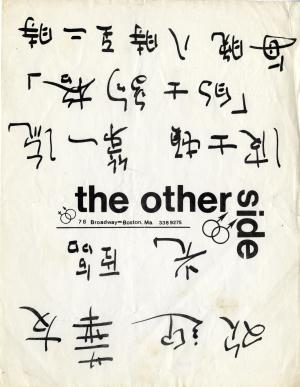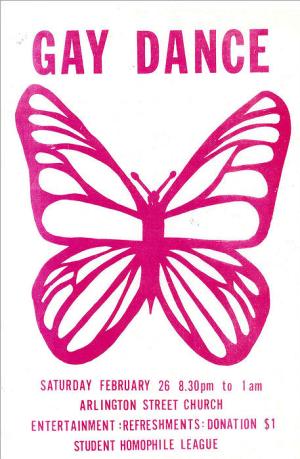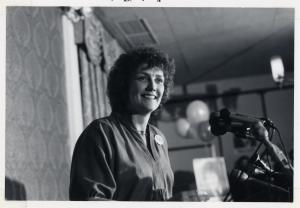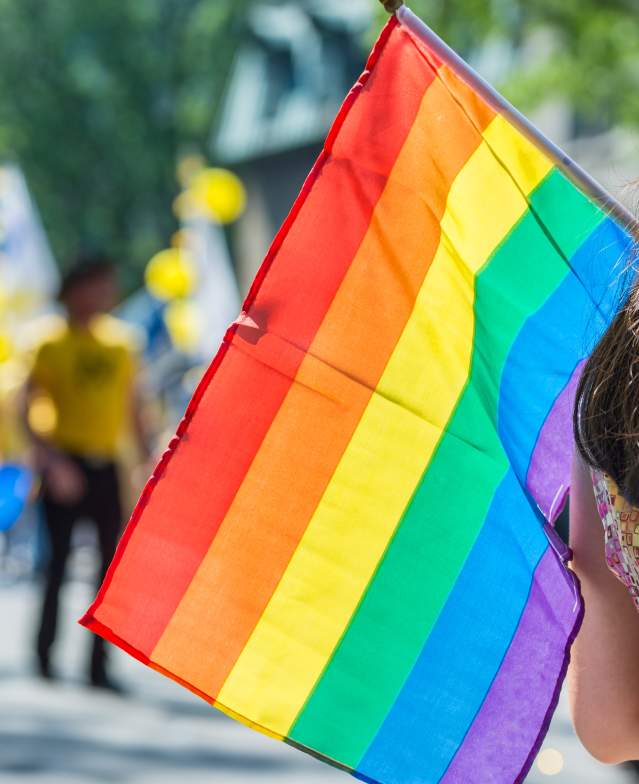The Boston Equality Trail
The first official Gay Pride March in Boston was held on Saturday, June 26, 1971. This was a distinctly political event that was preceded by a full week of workshops on various issues affecting the emerging gay community, such as coming out and gay spirituality. The march route encompassed four major stops: the Bay Village bar Jacques, Boston police headquarters on Berkeley Street, the State House on Beacon Hill, and St. Paul's Cathedral on Tremont Street. At each stop, a speaker presented a list of demands. When the marchers arrived at the State House, a call was issued to include homosexuals in civil rights legislation and eliminate anti-sodomy statutes dating from Puritan times. Speaker Laura McMurry told the throng, As gay people, we have been given a second-class citizenship. We demand an end to this now! We will not be put down any longer."
This walking tour follows the route of Boston's first Gay Pride March in 1971 and offers information about different services, community organizations, issues, and individuals related to this route.
The Flyer: "Two years ago on June 27, homosexuals in New York City for the first time refused OPPRESSION AS USUAL. They stood up when the Stonewall Bar on Christopher Street was raided ... We and others across the nation commemorate that event this June. We celebrate the awakening of a vigorous gay pride and self-respect."
Site 1: Jacques Cabaret and The Other Side (79 Broadway)
Opened in 1938, Jacques became a gay bar in the mid-1940s. In 1965, its owner also opened, directly across the street, The Other Side,the first discotheque in the city to allow same-sex dancing. After serving as the city's only lesbian bar from the late 1960s to the early 1970s, Jacques evolved into a venue for drag performers, which remains its focus to today.
The reason Boston's first Gay Pride March started here was to confront a number of community concerns directed at what is now the city's oldest surviving GLBT establishment, Jacques. Of primary importance to the march's organizers was the club's increasing problem with misogyny and the ill treatment of lesbian patrons.
List of Demands read outside Jacques:
- That the upstairs be for women only and that all men there must be accompanied by a woman
- There should be easily accessible fire escapes-without locks on them.
- That conditions, especially in bathrooms, be made more sanitary.
- That we be allowed to disseminate literature of interest to the gay community inside the bar.
- That there be a woman bartender.
- That we have control of the music played in Jacques; that we be allowed to choose records to go the jukebox.
- That Jacques recognizes a negotiation committee to implement these demands and others that come up in the future.
Site 2: Napoleon Club (52 Piedmont Street)
The Napoleon Club opened as a speakeasy in 1929 and later operated as a private club with a sizeable gay clientele. It wasn't until 1952, though, when under new ownership Napoleons became a gay bar and eventually a piano bar. Regular crooners were joined by such luminaries as Liberace and the Queen of Queens herself, Judy Garland, who visited the club every night for a week shortly before her death in 1969.
The Napoleon Club closed in 1998 and much of the contents of the establishment put up to auction. Its legacy lives on, though, in the Napoleon Room, a piano bar and lounge in ClubCafé, a GLBT restaurant and club on Columbus Avenue.
Site 3: Park Square (Intersection of Arlington and Stewart streets and Columbus Avenue)
Park Square and the Greyhound Bus Station formed a hub of gay activity in the late 1950s and early 1960s.
Park Square was also home to one of the most popular bars of the 1950s and 1960s, the Punch Bowl, which entertained huge crowds - and, on occasion, the vice squad, which longtime Boston resident Preston Claridge describes in an interview with The History Project: "About once a night they would flash the emergency lights, which meant that the vice were coming and you had to stop dancing with your boyfriend, since it was illegal back then. You could dance with a lesbian, or you could sit down."
Site 4: Boston's South End (Corner of Berkeley Street and Columbus Avenue)
The South End was originally settled by middle-class business owners, bankers, etc., but a series of financial crises at the turn of the twentieth century, as well as newer trendy neighborhoods like Back Bay popping up, lead to many wealthier people leaving the South End. Most residences in the area then became tenement houses which lead to lower-income immigrants, African Americans, and gays and lesbians living in the neighborhood. In the 1940s, the South End started to become a more attractive location for single gays and lesbians. The environment of single-sex rooming houses provided homes and social cover for unmarried gay and lesbian people to live together.
Many credit the renewed cultural vigor of the South End to its many GLBT artists and entrepreneurs who helped the neighborhood flourish beginning in the 1980s.
Site 5: Former Boston Police Department Headquarters (corner of Stanhope and Berkeley streets)
Marchers in Boston's first Gay Pride March in 1971 made their second stop here, to address issues related to police and the GLBT community. In his reminiscences of that day, Boston-based activist and writer Charley Shively described the scene outside the Police Headquarters: "...everything was locked up, and although we hadn't announced which police station we would confront, they seemed to know we were coming. The building was totally dead except for the ubiquitous camera lenses taking our pictures. A statement was read on the steps denouncing police brutality against homosexuals..."
It wasn't until 1978 that the BPD created a position that was to work directly with and to address the needs and concerns of members of the GLBT community.
List of Demands read outside Boston Police Departmentheadquarters:
- That all entrapment immediately cease.
- That vague laws, such as those against loitering, disorderly conduct, and lewd and lascivious behavior not be used to harass homosexuals.
- That the police provide protection, rather than harassment, in the areas around gay bars.
- That representatives of the police force enter into immediate discussions with representatives of the homophile organizations to facilitate communication and understanding and implement the above demands.
Site 6: Early Lesbian and Gay Organizations (419 Boylston Street)
The Homophile Union of Boston grew out of the Boston chapter of the Mattachine Society and was founded in late 1969 or early 1970. The organization's leadership was male, but there were also women members. The purpose of HUB was to provide a space for gay men and lesbians to talk about political and social issues affecting them and to offer a support network for member.
The Daughters of Bilitis (DOB) was a lesbian organization founded in 1955 in San Francisco by Del Martin and Phyllis Lyon for the purpose of self-knowledge and self-acceptance, public education, involvement in research, and lobbying to change the laws criminalizing homosexuality.
The Boston chapter was founded in 1969 during a period when many homophile organizations were forming in Boston. Early leaders of the Boston DOB included Lois Johnson, Shari Barden, and Laura Robin/McMurry, who were prominent promoters of the group and its activities.
Site 7: Arlington Street Church
Since the early 1970s, the Arlington Street Church on the corner of Boylston and Arlington streets, a Unitarian Universalist church, has been GLBT positive and affirming. Many groups have met here at one time or another, including the Homophile Union of Boston, BostonUnitarian Universalist Gay and Lesbians, Dignity-Boston, and the Boston Gay Men's Chorus. The city's first same-sex marriage ceremony (officially unrecognized of course) was held here in 1973.
Site 8: Boston Public Garden (Corner of Boylston and Charles streets)
The Public Garden was long a popular gay cruising site in Boston, especially during the time before WWII up until the 1980s. A Four Seasons hotel now stands where hustlers once patrolled opposite the Public Garden. In the 1980s, the city changed traffic patterns to discourage drivers from circling "The Block" (around Commonwealth, Arlington, and Marlborough streets) in their cars. The Public Garden is also presently home to a swan couple, Romeo and Juliet. These two female swans have been nesting around the lake since2005.
Site 9: Queen's Row and Sylvia Sidney (Corner of Beacon and Charles streets)
Boston's most infamous drag queen, Sylvia Sidney, once described himself as "a fun-loving, outspoken homosexual who speaks his mind and if people don't like it, the hell with them, my dear ... when I hit the stage I'm coarse, loud, and vulgar." He began his career as a drag performer in 1947, at the age of seventeen. Sidney received his stage name one day in the 1940s while walking through the Public Garden.
Sylvia Sidney died on December 16, 1998, but until shortly before his death was hosting a regularly night for drag at Jacques. Boston had lost a star comedian and entertainer, the self-proclaimed "Bitch of Boston."
Site 10: Charles Street (Corner of Charles and Beacon streets)
The Charles Street Meeting House at 70 Charles Street was once home to several early gay activist groups and publications. The Gay Community News (GCN), which ran from 1973 to 1992 as a weekly and until 1999 as a quarterly, published its first issue out of the Charles Street Meeting House. Gay Community News was an influential publication in Boston, across the country, and around the world.
For more on Gay Community News, read "An Army of Ex-Lovers" by Amy Hoffman and visit the digitized Gay Community News archives at http://historyproject.omeka.net/collections/show/35.
Site 11: Massachusetts State House
The Massachusetts State House, built in 1798, contains the Governor's offices, the House of Representatives, and the Massachusetts Senate. In 1974, Elaine Noble was elected the first openly gay person in the nation to hold an elective state office. She and then-State Representative Barney Frank subsequently sponsored a gay rights bill, which the legislature rejected. Over the years, the state house has been the site of many protests over GLBT rights issues and, in the early 2000s, saw Massachusetts become the first state in the United States to legalize same-sex marriage.
In 2001, seven same-sex couples from across the state applied for marriage licenses and were all denied. On April 11, 2001, Gay and Lesbian Advocates and Defenders (GLAD) filed a lawsuit, Goodridge v. Department of Public Health, arguing that denying same-sex couples equal marriage rights was unconstitutional under the state constitution. The Suffolk SuperiorCourt ruled against the plaintiffs in May 2002, a decision that GLAD appealed to the Massachusetts Supreme Judicial Court. On November 18, 2003, the Supreme Judicial Court ruled 4 to 3 that the state's ban on same-sex marriage was unconstitutional. The ruling states:
The Massachusetts Constitution affirms the dignity and equality of all individuals. It forbids the creation of second-class citizens. In reaching our conclusion we have given full deference to the arguments made by the Commonwealth. But it has failed to identify any constitutionally adequate reason for denying civil marriage to same-sex couples.
The state began issuing marriage licenses to same-sex couples on May 17, 2004, the fiftieth anniversary of the Brown v. the Board of Education ruling. The Goodridge ruling sent shockwaves across the country.
The State House was the third stop at the first Gay PrideMarch in 1971 and was a way for marchers to confront "persecution of homosexuals by the state."
List of Demands read outside the Massachusetts State House:
- That all the following laws pertaining to homosexuality be repealed: Mass. Chapter 272, S. 34, S.35, and city ordinance against same sex dancing together.
- That legislation be enacted to end discrimination against people in employment, housing, and in the use of public facilities because of their sexual orientation.
Site 12: St. Paul'sCathedral (138 Tremont Street)
St. Paul's has a long history of supporting the GLBT community in Boston. Some of the earliest public healing services for people with AIDS were held here. The Episcopal faith was one of the first Christian groups to recognize same-sex marriages and to create a same-sex marriage ceremony. The church also allows for the leadership of gay and lesbian bishops.
St. Paul's is also supportive of the trans community in Boston, celebrating the Transgender Day of Remembrance and hosting events for the trans community. Members of the St. Paul's community have been marching against homophobia and for GLBT rights in Boston Pride for years, and generally hold a post-march celebration for all who want to attend.
At the first Gay Pride March in 1971 a list of demands were presented outside St. Paul's, denouncing centuries of religious persecution of homosexuals.
List of Demands read outside St. Paul's Cathedral:
- That the church accept qualified gay persons for ordination and other religious work.
- That the church include comprehensive courses on human sexuality in seminary training, and for men and women already in religious work.
- That it develop and use curriculum material on human sexuality in Sunday School or in Church School.
- That the church recognize and bless the love of homosexuals as it does for heterosexuals.
- That the church lend its support to the reexamination of the institution of marriage and the family, which in its present form legally discriminates against homosexuals.
- That the church lend its support to the reexamination of roles based on sex, with particular attention to the fact that its support of these sex roles has oppressed women and homosexuals.
Site 13: Parkman Bandstand (Boston Common)
The first Gay Pride March in 1971 ended at the Parkman Bandstand where, according to Charley Shively's account, "a closet-smashing and book-dumping" took place. Shively writes: "The cardboard closet was ripped apart and thrown in a trash-can along with cardboard signs of infamous books by psychiatrists, whose names hardly bear repeating."
The bandstand was most recently renovated in 1996 and is a common meeting point for events and rallies of all kinds, including Boston Pride, the annual Youth Pride March, and for the annual Boston Dyke March. The Bandstand was also a longtime location of the annual Pride Festival, during Boston Pride, and at that first Gay Pride March in 1971, this was certainly the case. Currently, the Pride Festival takes place at the Government Center.

Flyer for the Other Side. Image courtesy of The History Project: Documenting GLBT Boston

Performers in the Napoleon Room at Club Café. The stained glass panel above the piano, on loan from the archives of The History Project, originally hung over the bar at the Napoleon Club. Image courtesy of The History Project: Documenting GLBT Boston.

The Napoleon Club Logo. Image courtesy of The History Project: Documenting GLBT Boston

Thenewsletter for the Boston Chapter of the Daughters of Bilitis, called Focus, was published from 1969 to 1983. Image courtesy of The History Project: Documenting GLBT Boston.

Gay Dance - Arlington Street Church image, Caption: The Homophile Union of Boston, the Student Homophile League, and the Daughters of Bilitis used to hold gay dances in the Boston area, including at the Arlington Street Church. Image courtesy of The History Project: Documenting GLBT Boston

Sylvia Sidney image, Caption: Legendary Boston drag performer Sylvia Sidney, circa 1945. Image courtesy of The History Project: Documenting GLBT Boston.

Marchers at Boston's first Gay Pride March outside the Massachusetts State House, 1971. Image courtesy of The History Project: Documenting GLBT Boston.

Elaine Noble is an American politician and GLBT activist who served in the Massachusetts House of Representatives for two terms starting in January 1975. She was the first openly lesbian or gay candidate elected to a state legislature in the UnitedStates. She served two terms as representative for the Fenway-Kenmore/Back Bay neighborhoods of Boston. Image courtesy of The History Project: Documenting GLBT Boston.



